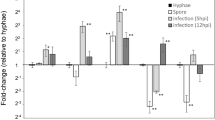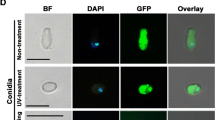Abstract
Spa2 is an important component of the multiprotein complex polarisome, which is involved in the establishment, maintenance, termination of polarized cell growth and is important for defining tip growth of filamentous fungi. In this study, we isolated an insertional mutant of the rice blast fungus Magnaporthe oryzae that formed smaller colony and conidia compared with the wild type. In the mutant, a spindle pole antigen gene MoSPA2 was disrupted by the integration of an exogenous plasmid. Targeted gene deletion and complementation assays demonstrated the gene disruption was responsible for the defects of the insertional mutant. Interestingly, the MoSpa2-GFP fusion protein was found to accumulate as a spot at hyphal tips, septa of hyphae and conidial tip cells where germ tubes are usually produced, but not in appressoria, infection hyphae or at the septa of conidia. Furthermore, the deletion mutants of MoSPA2 exhibited slower hyphal tip growth, more hyphal branches, and smaller size of conidial tip cells. However, MoSPA2 is not required for plant infection. These results indicate that MoSPA2 is required for vegetative hyphal growth and maintaining conidium morphology and that spotted accumulation of MoSpa2 is important for its functions during cell polar growth.






Similar content being viewed by others
References
Amberg DC, Zahner JE, Mulholland JW, Pringle JR, Botstein D (1997) Aip3p/Bud6p, a yeast actin-interacting protein that is involved in morphogenesis and the selection of bipolar budding sites. Mol Bio Cell 8:729–753
Carbo N, Perez-Martin J (2008) Spa2 is required for morphogenesis but it is dispensable for pathogenicity in the phytopathogenic fungus Ustilago maydis. Fungal Genet Biol 45:1315–1327
Crampin H, Finley K, Gerami-Nejad M, Court H, Gale C, Berman J, Sudbery P (2005) Candida albicans hyphae have a Spitzenkorper that is distinct from the polarisome found in yeast and pseudohyphae. J Cell Sci 118:2935–2947
Delgehyr N, Lopes CS, Moir CA, Huisman SM, Segal M (2008) Dissecting the involvement of formins in Bud6p-mediated cortical capture of microtubules in S. cerevisiae. J Cell Sci 121:3803–3814
Du Y, Shi Y, Yang J, Chen X, Xue M, Zhou W, Peng YL (2013) A serine/threonine-protein phosphatase PP2A catalytic subunit is essential for asexual development and plant infection in Magnaporthe oryzae. Curr Genet 59:33–41
Gehrung S, Snyder M (1990) The SPA2 gene of Saccharomyces cerevisiae is important for pheromone-induced morphogenesis and efficient mating. J Cell Biol 111:1451–1464
Gouet P, Courcelle E, Stuart DI, Metoz F (1999) ESPript: analysis of multiple sequence alignments in PostScript. Bioinformatics 15:305–308
Harris SD (2006) Cell polarity in filamentous fungi: shaping the mold. Int Rev Cytol 251:41–77
Harris SD (2008) Branching of fungal hyphae: regulation, mechanisms and comparison with other branching systems. Mycologia 100:823–832
Harris SD (2009) The Spitzenkorper: a signalling hub for the control of fungal development? Mol Microbiol 73:733–736
Jeon J, Park SY, Chi MH, Choi J, Park J, Rho HS, Kim S, Goh J, Yoo S, Choi J, Park JY, Yi M, Yang S, Kwon MJ, Han SS, Kim BR, Khang CH, Park B, Lim SE, Jung K, Kong S, Karunakaran M, Oh HS, Kim H, Kim S, Park J, Kang S, Choi WB, Kang S, Lee YH (2007) Genome-wide functional analysis of pathogenicity genes in the rice blast fungus. Nat Genet 39:561–565
Jones LA, Sudbery PE (2010) Spitzenkorper, exocyst, and polarisome components in Candida albicans hyphae show different patterns of localization and have distinct dynamic properties. Eukaryot Cell 9:1455–1465
Knechtle P, Dietrich F, Philippsen P (2003) Maximal polar growth potential depends on the polarisome component AgSpa2 in the filamentous fungus Ashbya gossypii. Mol Biol Cell 14:4140–4154
Kohli M, Galati V, Boudier K, Roberson RW, Philippsen P (2008) Growth-speed-correlated localization of exocyst and polarisome components in growth zones of Ashbya gossypii hyphal tips. J Cell Sci 121:3878–3889
Lichius A, Yanez-Gutierrez ME, Read ND, Castro-Longoria E (2012) Comparative live-cell imaging analyses of SPA-2, BUD-6 and BNI-1 in Neurospora crassa reveal novel features of the filamentous fungal polarisome. PLoS ONE 7:e30372
Lu S, Lyngholm L, Yang G, Bronson C, Yoder OC, Turgeon BG (1994) Tagged mutations at the Tox1 locus of Cochliobolus heterostrophus by restriction enzyme-mediated integration. Proc Natl Acad Sci 91:12649–12653
Meyer V, Arentshorst M, van den Hondel CA, Ram AF (2008) The polarisome component SpaA localises to hyphal tips of Aspergillus niger and is important for polar growth. Fungal Genet Biol 45:152–164
Park G, Bruno KS, Staiger CJ, Talbot NJ, Xu JR (2004) Independent genetic mechanisms mediate turgor generation and penetration peg formation during plant infection in the rice blast fungus. Mol Microbiol 53:1695–1707
Patkar RNI, Suresh A, Naqvi NI (2010) MoTea4-mediated polarized growth is essential for proper asexual development and pathogenesis in Magnaporthe oryzae. Eukaryot Cell 9:1029–1038
Peng YL, Shishiyama J (1988) Temporal sequence of cytological events in rice leaves infected with Pyricularia oryzae. Can J Bot 66:730–735
Roemer T, Vallier L, Sheu YJ, Snyder M (1998) The Spa2-related protein, Sph1p, is important for polarized growth in yeast. J Cell Sci 111(Pt 4):479–494
Saitou N, Nei M (1987) The neighbor-joining method: a new method for reconstructing phylogenetic trees. Mol Biol Evol 4:406–425
Sambrook J, Russell DW (2001) Molecular cloning: a laboratory manual. Cold Spring Harbor Laboratory Press, Cold Spring Harbor
Sheu YJ, Santos B, Fortin N, Costigan C, Snyder M (1998) Spa2p interacts with cell polarity proteins and signaling components involved in yeast cell morphogenesis. Mol Cell Biol 18:4053–4069
Shimizu J, Yoda K, Yamasaki M (1994) The hypo-osmolarity-sensitive phenotype of the Saccharomyces cerevisiae hpo2 mutant is due to a mutation in PKC1, which regulates expression of beta-glucanase. Mol Gen Genet 242:641–648
Sweigard JA, Carroll AM, Farrall L, Chumley FG, Valent B (1998) Magnaporthe grisea pathogenicity genes obtained through insertional mutagenesis. Mol Plant Microbe Interact 11:404–412
Talbot NJ, Kershaw MJ, Wakley GE, De Vries O, Wessels J, Hamer JE (1996) MPG1 encodes a fungal hydrophobin involved in surface interactions during infection-related development of Magnaporthe grisea. Plant Cell 8:985–999
Tamura K, Dudley J, Nei M, Kumar S (2007) MEGA4: molecular evolutionary genetics analysis (MEGA) software version 4.0. Mol Biol Evol 24:1596–1599
Tcheperegine SE, Gao XD, Bi E (2005) Regulation of cell polarity by interactions of Msb3 and Msb4 with Cdc42 and polarisome components. Mol Cell Biol 25:8567–8580
Valtz N, Herskowitz I (1996) Pea2 protein of yeast is localized to sites of polarized growth and is required for efficient mating and bipolar budding. J Cell Biol 135:725–739
van Drogen F, Peter M (2002) Spa2p functions as a scaffold-like protein to recruit the Mpk1p MAP kinase module to sites of polarized growth. Curr Biol 12:1698–1703
Virag A, Harris SD (2006) Functional characterization of Aspergillus nidulans homologues of Saccharomyces cerevisiae Spa2 and Bud6. Eukaryot Cell 5:881–895
Xu JR, Hamer JE (1996) MAP kinase and cAMP signaling regulate infection structure formation and pathogenic growth in the rice blast fungus Magnaporthe grisea. Genes Dev 10:2696–2706
Yang J, Zhao X, Sun J, Kang Z, Ding S, Xu JR, Peng YL (2010) A novel protein Com1 is required for normal conidium morphology and full virulence in Magnaporthe oryzae. Mol Plant Microbe Interact 23:112–123
Zheng XD, Wang YM, Wang Y (2003) CaSPA2 is important for polarity establishment and maintenance in Candida albicans. Mol Microbiol 49:1391–1405
Acknowledgments
This work was supported by Chinese Universities Scientific Fund (Grant No. 2013XJ012) and National Fundamental Basic Research program (Grant No. 2012CB114002) of the Ministry of Sciences and Technology, China.
Conflict of interest
We declared that no conflict of interest exists.
Author information
Authors and Affiliations
Corresponding author
Additional information
Communicated by S. Hohmann.
Nucleotide sequence data are available in the GenBank database under the accession number KF201869 (MoSPA2).
Electronic supplementary material
Below is the link to the electronic supplementary material.
294_2014_431_MOESM1_ESM.tif
Fig. S1 Phylogenetic tree of fungal Spa2 proteins. Protein sequences were aligned using the programs ClustalX and Mega 4.0 to create the dendrogram. A. fumigates, Aspergillus fumigatus Spa2 (XM744410.1); A. gossypii, Ashbya gossypii Spa2 (NM209428.1); A. nidulans, Aspergillus nidulans SpaA (XM656327.1); A. niger, Aspergillus niger SpaA (EF474481); C. albicans, Candida albicans Spa2 (XM706557.1); G. zeae, Gibberella zeae Spa2 (XP_381108.1); M. oryzae, Magnaporthe oryzae Spa2 (XP_003716178.1); N. crassa, Neurospora crassa Spa2 (XM959881.1); S. cerevisiae, Saccharomyces cerevisiae Spa2 (NM209428.1); U. maydis, Ustilago maydis Spa2 (XP_760615.1). The numbers at nodes represent the percentage of branch support of 1,000 bootstrap replicates, and the scale bar indicates the number of amino acid differences per site (TIFF 156 kb)
294_2014_431_MOESM2_ESM.tif
Fig. S2 Alignment of the SHD-I of fungal Spa2 homologs. Alignment of the conserved domain of Spa2 from M. oryzae with those from other organisms (shown in Fig. S1) was performed using ClustalX and ESPript programs. The region of highest homology corresponds to the SPA2 direct repeat (SDR, Roemer et al. 1998) and is indicated by arrows (TIFF 1041 kb)
294_2014_431_MOESM3_ESM.tif
Fig. S3 Nuclei and septa in vegetative hyphae of the wild-type P131, the ∆Mospa2 null mutant MH1, and one complementation strain CM20 were co-stained by Hoechst 33258 and Calcofluor White. The white arrows and triangles point to the septa and nuclei, respectively. Bar = 20 μm (TIFF 1217 kb)
Rights and permissions
About this article
Cite this article
Li, C., Yang, J., Zhou, W. et al. A spindle pole antigen gene MoSPA2 is important for polar cell growth of vegetative hyphae and conidia, but is dispensable for pathogenicity in Magnaporthe oryzae . Curr Genet 60, 255–263 (2014). https://doi.org/10.1007/s00294-014-0431-4
Received:
Revised:
Accepted:
Published:
Issue Date:
DOI: https://doi.org/10.1007/s00294-014-0431-4




